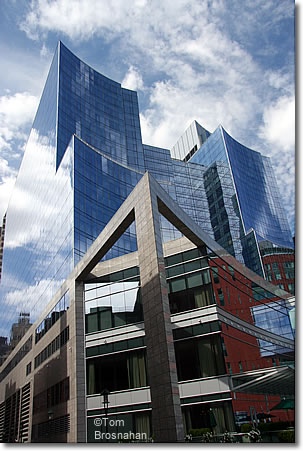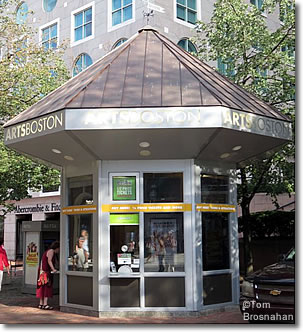Prices & Costs in New England
New England is not the cheapest part of the USA, but you get value for money here, whether you're buying dinner or a room for the night.

InterContinental Hotel Boston: magnificent, but not cheap.
Surveys name Boston as the third most expensive city in the continental USA for tourists (after San Francisco and New York City).
The main culprit is hotel prices, but other travel expenses—restaurant meals, parking, attractions, etc.—are up there as well. (I regularly visit Paris, France for FranceTravelPlanner.com, and I find prices there delightfully lower than Boston's...)
But Boston is not all of New England, so a New England vacation need not break your budget. Besides, there are ways to enjoy even the pleasures of Boston at discounted prices.
You must also be aware of the tyranny of taxes and tips.
Here are some general budget guidelines for daily costs, per person. These costs assume two people are traveling together, sharing lodging and, in the case of a rental car, transportation:
Budget Travel: $100 to $170
Traveling on a thrifty budget in New England means not just looking for discounts and special deals (although that's important), but adhering to a certain lifestyle. Stay in hostels and camping areas, travel by bus, make your own picnics at least once a day, and choose value-for-money meals and you can travel New England for $90 to $150 per person per day.
$95-$125 |
||
Inexpensive city-center hotel, double room |
$150-$200 |
|
State park tent-camping site, per night |
$30-$44 |
|
Sandwich/light lunch & drink in a resort area |
$15-$22 |
|
Dinner in simple restaurant, 2 courses & drink |
$30-$45 |
|
New York City - Boston bus ticket, one-way |
$10-$43 |
|
MBTA bus/subway (Metro) fare, Boston |
$1.70-$2.40 |
|
Admission to Boston Museum of Fine Arts |
$10-$27 |
|
$53 |
Money-Saving Tips
- Take the ferry to Cape Cod, Nantucket or Martha's Vineyard for a day-trip rather than staying the night there.
- Eschew the pricey Italian restaurants of Boston's North End, but buy picnic supplies in one of its Italian groceries.
- Attend weekday music and dance performances at summer arts festivals (such as in Massachusetts' Berkshire Hills) rather than the more-expensive performances on weekends.
Here are more specific tips:
Lodging
Hostelling International has fine travelers' hostels in Bennington VT, Bethel ME, Boston MA, Cape Cod MA (Eastham, Hyannis & Truro), Littleton MA (west of Boston), Martha's Vineyard MA, Nantucket MA, and White River Junction VT.
Larger cities (such as Boston) and the most popular resort areas (for example, Bar Harbor ME) may have other independent hostels and budget hotels as well.
Reserve your bed(s) in advance, particularly in popular destinations such as Boston, Martha's Vineyard and Nantucket, as these will always be fully booked in high season (summer, autumn foliage season, holidays).
Here's how to find and use a New England campground.
Food & Drink
Think picnics! New England has an endless variety of places to picnic, from organized picnic areas in parks to sidewalk benches and rock walls looking out to sea. Many grocery stores and supermarkets—and the Boston Public Market—now offer quite a variety of prepared foods making picnics even easier. Take advantage!
Drink Water, Save Money
Any quick-stop place to buy food or snacks will have a cold case or vending machine filled with expensive soft drinks and bottled water.
Although some fast-food and light-meal take-out restaurants will fulfill a request for a glass of water, some will suggest that you buy a bottle of water ($1 to $2.50) instead.
Bring your own water bottle, fill it at taps or drinking fountains, and always have it with you, even in restaurants. This will save lots of money on drinks.
In food courts (collections of prepared food sellers with common seating), there is usually a drinking fountain available, often near the toilets. Fill your water bottle there. (If you don't see it, ask!)
About 50 billion plastic water bottles are sold annually in the USA, but only 23% of them are recycled—a colossal waste of money and resources.
Transportation
Going by bus between New York City and Boston can be cheap or expensive, depending on the company, the departure time, when and how you buy your ticket. Research the possibilities ahead of time and find the bargains.
For trains, a few Amtrak Regional trains traveling between New York and Boston are almost as fast as the Acela high-speed, but at a lower fare. Study the schedules and look for the faster trains.
Attractions
Bostix, selling same-day half-price tickets to theaters, concerts and other events in Boston is a good example of what to look for.

Bostix by Arts Boston: cheap same-day theater, concert & event tickets.
Many museums have discounted or even free admission at certain times. For Boston's superb Museum of Fine Arts, Youth (7 to 17) admission is free on weekends, holidays, and on weekdays after 3 pm.
Lots of cities, towns and even villages sponsor free concerts and plays in parks during the summer.
Moderate-Cost Travel: $175 to $250
Choose suburban motels and B&B guest houses near (but not in) the expensive cities and resort areas, visit cities on weekends and resorts from Sunday through Thursday, rent a car for a week or more (using your own car insurance, not the rental company's), choose restaurant meals carefully, have the occasional picnic, and you can travel for $175 to $250 per person, per day.
New England Hotel Map with Prices
Comfort Travel: $250 to $400
On this budget, you can stay in city-center hotels and country inns, dine in good (but not deluxe) restaurants some days, travel by comfortable rental car, and spend from $175 to $300 per person, per day.
Luxury Travel: $400+
Living among the 1%, there's no limit to what you can spend on the top hotels, inns, resorts, cars and flights, and the best restaurants. (At Vermont's exclusive Twin Farms Resort and Spa, room prices are around $2,600 to $6,700 per night.)
Transportation
You can travel in New England by public transportation: intercity buses, trains, ferryboats and flights, but public transportation in the USA is not as widespread or as efficient as in some other countries, such as in Europe. In the USA, the car is king, and only a car gives you the freedom to move quickly and directly along your chosen itinerary. If you don't have your own car in the USA, you'll probably want to rent one. More...
Prices, Taxes & Tips
When is the price not the full price? When you rent a room or buy a meal in the USA.
In some popular tourist-destination countries, including France, the world's No. 1 tourist destination, prices are generally all-inclusive and thus transparent: if you see a price of 20 euros, you pay 20 euros and walk away.
In the USA, it's a lot more complicated. In many cases, the price you see is only part of what you will ultimately pay. Those charging the prices want it this way, even though it's bad for you.
Tax is Added
The major factor obscuring what you ultimately pay is taxes. For many goods and services that travelers buy in the USA, taxes are generally added to the price, not included in it. This is true for lodgings, restaurant meals, some transportation, and for most general shopping (except groceries and some clothing).
Merchants want it this way. The reason they give is that they want their customers to see and realize what the merchant earns from the sale and, separately, what the government earns. This may be true, but it also obscures the full and true price to buyers when they are making the decision whether or not to buy. They only know the full price after they have made the decision to buy.
Lodging Taxes: the Highest
Lodging taxes are among the biggest—up to 13% or more. So if you see a hotel room priced at $200 per night, you may actually pay $226 ($200 + 13% room tax.)
New York City is a champ at this. If your hotel room is priced at $250, you will also pay New York State Sales Tax of 4%, New York City Sales Tax of 4.5%, a Transportation District Surcharge of 0.375%, a Hotel Room Occupancy Tax of $2 + 5.875%, and an Additional Daily Fee (?...!) of $1.50, for a total of $290.38, a total of 16% more than the "price" of the room.
At an inn in Lexington MA, the tax on your stay is 11.75%, plus there's a mysterious $30-per-day "resort fee" to pay.
It would be so much easier for the traveler if all of these extra taxes and fees were included in the original price advertised.
Restaurant Taxes: Most Tedious
You sit down in a restaurant, order several courses and drinks from the menu, and add up the prices from the menu: $50. When you leave the restaurant, you will have paid more like $64, that is, about 28% more than "the prices."
What? How?!
$50 for your dinner, plus the all-but-obligatory tip (see below), plus a meals tax of something like 6.25%, the rate in Massachusetts. (Rhode Island charges only 1%, but Maine charges 8%, Vermont and New Hampshire 9%.)
Tipping: Biggest Markup of All
Americans complain about costs, but they are perhaps the only people in the world who insist on paying more than the price for goods and services.
Americans give tips ("gratuities") to nearly everyone they encounter. Tips may range from 10% (once the norm, now universally looked upon as too little) to 15% (once standard, now looked upon as stingy) to 20% and even 25% (rapidly becoming the standard). In some establishments, prices are pumped up by things like a "mandatory 22% gratuity"! Since when is a gratuity (ie, something given voluntarily) mandatory?
Because tipping is so engrained in American commercial life, many service providers make it easy for people to give tips. Who doesn't like free money?
The Worst: Restaurant Tips
The most tedious of tipping situations is in restaurants. You have ordered from the menu, enjoyed your meal and good service, and you ask for your check (bill). The dishes and drinks you enjoyed are listed on the bill with prices, as is the substantial tax, which is not included in the prices.
Below the total of meal + taxes will be a line for you to write in the amount of any tip. So, replete with a good dinner and glass of wine, you are required to solve an arithmetic problem: you must calculate the amount you want to pay the waiters for doing their job.
If you calculate the amount on the meal + taxes total, you will be tipping the waiter for the tax the government levies as well as for the meal ordered.
The tip you pay does indeed go to the waiters. But wait! What about all the other restaurant staff? The host, the chef, the cooks, those who clear the tables, the business managers.... They work just as hard, but often receive none of the tip. Is this fair?
It gets worse. Waiters are supposed to declare the tips they receive as income for tax purposes. In some (many?) cases, tip income is received in the form of cash, and is therefore untraceable. Some waiters may not report it, and thus not pay their fair share of the national tax burden.
Why not include tax and service (tip) in prices and let customers know at the beginning the full price they will pay? Merchants can itemize tax and service on the bill if they wish you to see what goes where. Everyone on the staff in restaurants and other service businesses can share in the profits, and the government can levy taxes fairly on all workers.
A Broken System
"Plus tax and tip" is a broken system, but it's what you will encounter in the USA.
